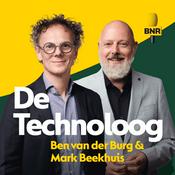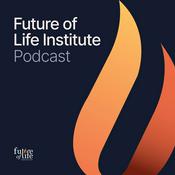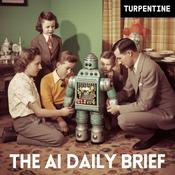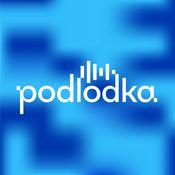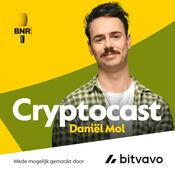321 afleveringen
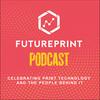
#307 - AI, Convergence, and the Next Era of Print – with Nathan Safran, VP Research, PRINTING United Alliance
20-12-2025 | 31 Min.
Send us a textIn this episode, Marcus Timson is joined by Nathan Safran, Vice President of Research at PRINTING United Alliance, for an in-depth exploration of the biggest forces reshaping the global print industry.Safran shares findings from the Alliance’s latest research—covering AI adoption, automation, convergence, economic signals, and where PSPs are creating new value.Key Themes Discussed:AI moves mainstream: 85% of PSPs now view AI as critical to competitiveness, with 83% saying it opens new business opportunities—not just productivity gains.Real-world AI applications: From generative design and marketing personalisation to advanced forecasting, quality inspection, and in-house software development, PSPs are adopting AI at a pace not seen before.The importance of data: AI success depends on clean, structured, reliable data. PSPs must put their “data house in order” to unlock higher-value use cases.Automation + AI: A powerful combination that is reshaping prepress, production, onboarding, and back-office functions across sales, finance, and operations.Convergence as a structural trend: Commercial into wide format, wide format into labels or packaging, and a broader shift toward multi-segment capability as buyers choose vendors who can do more.Growth opportunities for 2026: Strategic diversification, AI-led transformation, and offering adjacent digital services such as design, data management, and campaign execution.Safran emphasises that print companies are increasingly transforming into technology-enabled service providers, and that PSPs who embrace both data and AI will have significant competitive advantage.A fascinating, forward-looking conversation packed with insight for anyone in print, manufacturing, or related markets.Listen on:Apple PodcastGoogle PodcastSpotifyWhat is FuturePrint? FuturePrint is a digital and in person platform and community dedicated to future print technology. Over 20,000 people per month read our articles, listen to our podcasts, view our TV features, click on our e-newsletters and attend our in-person and virtual events. We hope to see you at one of our future in-person events:FuturePrint TECH: Industrial Print: 21-22 January '26, Munich, Germany

#306 - From Drop Formation to Functional Manufacturing: Ardeje Printing and the Expanding Role of Industrial Inkjet
19-12-2025 | 16 Min.
Send us a textIn this episode of the FuturePrint Podcast, host Frazer Chesterman speaks with Victor Perraudin, Research and Development Engineer at Ardeje Printing, a specialist developer of industrial drop-on-demand inkjet systems.Founded in 1997, Ardeje Printing has grown alongside the digital printing revolution, focusing not on graphics but on bespoke industrial inkjet solutions where print performs a functional role. Perraudin explains how Ardeje works at the intersection of materials science, fluid dynamics and system integration, supporting customers with applications that go far beyond flat substrates and conventional inks.The conversation explores Ardeje’s Origin D100 R&D platform, designed to bridge the gap between laboratory experimentation and production deployment. Using this system, Ardeje supports applications ranging from silver inks for printed electronics, antennas and conductive tracks, to carbon nanotube sensors, quantum dot deposition and sol-gel printing.Perraudin discusses growing interest from sectors such as photovoltaics, batteries, EV technologies, medical devices and construction, where inkjet is increasingly seen as a precise, low-waste method for functional material deposition. He also highlights the challenges shaping the next phase of industrial inkjet, including printing on complex 3D geometries, REACH-driven reformulation of UV inks, and demand for high-viscosity, non-conventional fluids.Looking ahead, Perraudin outlines a future where drop-on-demand inkjet evolves from decoration to integrated functional manufacturing, supported by smarter data-driven processes and deeper collaboration across the inkjet ecosystem.Ardeje will be presenting at FuturePrint Industrial Print in Munich, where functional inkjet applications will be firmly in the spotlight.Listen on:Apple PodcastGoogle PodcastSpotifyWhat is FuturePrint? FuturePrint is a digital and in person platform and community dedicated to future print technology. Over 20,000 people per month read our articles, listen to our podcasts, view our TV features, click on our e-newsletters and attend our in-person and virtual events. We hope to see you at one of our future in-person events:FuturePrint TECH: Industrial Print: 21-22 January '26, Munich, Germany

#305 - Next-Generation Barcodes and the Future of Connected Packaging: A Conversation with GS1 UK’s Camilla Young
18-12-2025 | 31 Min.
Send us a textIn this episode we dive into one of the most significant – yet often misunderstood – transformations underway in global retail and packaging: the shift from traditional barcodes to next-generation QR codes powered by GS1. Our guest, Camilla Young, leads this programme for GS1 UK and has rapidly become one of the most compelling voices in the space.With a commercial background spanning major CPG brands such as Pernod Ricard, BIC, Hasbro and Johnson & Johnson, Camilla brings a rare blend of brand insight, consumer understanding, and technical clarity to a topic that is reshaping how products are made, sold, tracked, understood, and recycled.We explore:What GS1 actually does and why global standards underpin the entire retail and supply chain ecosystem.The forces driving change: consumer expectations, sustainability pressure, EU regulations, digital shopping, and AI.The difference between ordinary QR codes and GS1 Digital Link QR codes – and why next-generation barcodes can now scan at POS.The vast potential for connected packaging, from traceability and recalls to accessibility, authentication, and first-party consumer engagement.Why printers, converters, and packaging suppliers have a critical role in ensuring print quality, verification, and correct implementation.How this shift will enable digital product passports, carbon transparency, circularity, and smarter supply chains.Camilla shares clear, practical explanations that demystify what is coming – and why the print and packaging sector should be fully informed and preparing now.For more information: GS1 UK – gs1uk.org Global GS1 – gs1.orgFollow Camilla on LinkedIn for updates, case studies, and live examples of next-generation barcodes being deployed around the world.Listen on:Apple PodcastGoogle PodcastSpotifyWhat is FuturePrint? FuturePrint is a digital and in person platform and community dedicated to future print technology. Over 20,000 people per month read our articles, listen to our podcasts, view our TV features, click on our e-newsletters and attend our in-person and virtual events. We hope to see you at one of our future in-person events:FuturePrint TECH: Industrial Print: 21-22 January '26, Munich, Germany

#304 - If You Cannot Measure It, You Cannot Control It: Why UV measurement is becoming mission-critical for industrial print
17-12-2025 | 18 Min.
Send us a textIn this episode of the FuturePrint Podcast, Frazer Chesterman speaks with Jim Raymont, Director of Sales at EIT 2.0, and PK Swain, Chief Operating Officer, to explore the critical role UV measurement plays in modern industrial inkjet manufacturing. As EIT 2.0 prepares to exhibit at FuturePrint Industrial Print Munich, the conversation goes deep into the practical realities of curing, process control and efficiency on the production floor.Jim explains how EIT 2.0, formed in 2022 as a specialist offshoot of the original EIT, builds on nearly four decades of UV measurement expertise. PK brings additional perspective from senior leadership roles at major UV source manufacturers, offering insight into both the technology and business impact of getting curing right - or wrong.Together, they highlight a recurring challenge across the industry: when curing problems arise, finger-pointing often replaces diagnostics. EIT’s instruments act as a neutral communication tool, helping source suppliers, formulators and end users establish clear process windows and quickly identify issues before scrap, downtime and cost escalate.The discussion also tackles common misconceptions around UV LED curing. While LEDs are stable and energy efficient, they still degrade over time and are vulnerable to real-world production variables - contamination, speed changes and incorrect settings. Measuring UV output is the only way to maintain control.The episode closes with a look at sustainability, LED adoption and why UV measurement should start at process development - not when problems occur. A must-listen for anyone serious about industrial print performance.Listen on:Apple PodcastGoogle PodcastSpotifyWhat is FuturePrint? FuturePrint is a digital and in person platform and community dedicated to future print technology. Over 20,000 people per month read our articles, listen to our podcasts, view our TV features, click on our e-newsletters and attend our in-person and virtual events. We hope to see you at one of our future in-person events:FuturePrint TECH: Industrial Print: 21-22 January '26, Munich, Germany

#303 - Beyond the RIP: Anna Tobler on Software, Productivity and the New Era of AI Support
16-12-2025 | 18 Min.
Send us a textIn this episode of the FuturePrint Podcast, Ed sits down with Anna Tobler, CEO of Ergosoft, ahead of her participation at the FuturePrint AI for Industrial Print Conference in Munich this January. Anna shares her journey from a career in IT and financial services to leading one of the print industry’s most respected software companies, known globally for its RIP technology across textile, décor, large format and industrial printing.Anna outlines the shifting dynamics shaping today’s print environment – from shorter runs and rising quality expectations to increasing workflow complexity and the pressure on operators to “know everything.” With hardware becoming faster, more stable and more capable, she argues that workflow, automation and software intelligence are now the real differentiators. The conversation highlights how smart job preparation, bottleneck elimination and AI-enhanced decision-making can significantly boost productivity and reduce errors.A major focus of the episode is Ergosoft’s development of Casey, the company’s AI agent designed to deliver instant, 24/7 multilingual support. Anna explains how Casey was trained on Ergosoft’s expert knowledge base and continuously evolves with every update, giving customers immediate access to guidance, troubleshooting and best practices. She also shares some of the surprising and amusing lessons learned while fine-tuning Casey’s behaviour – including the need to stop it from offering cooking recipes or praising competitors a little too enthusiastically.Looking ahead, Anna discusses the accelerating pace of technological change, the growing importance of intuitive front-end experiences powered by complex back-end logic, and the challenge of using AI to empower rather than overwhelm users. It’s an insightful conversation full of practical perspective on the future of workflow, software and AI in print.Listen on:Apple PodcastGoogle PodcastSpotifyWhat is FuturePrint? FuturePrint is a digital and in person platform and community dedicated to future print technology. Over 20,000 people per month read our articles, listen to our podcasts, view our TV features, click on our e-newsletters and attend our in-person and virtual events. We hope to see you at one of our future in-person events:FuturePrint TECH: Industrial Print: 21-22 January '26, Munich, Germany
Meer Technologie podcasts
Trending Technologie -podcasts
Over FuturePrint Podcast
Luister naar FuturePrint Podcast, Bright Podcast en vele andere podcasts van over de hele wereld met de radio.net-app

Ontvang de gratis radio.net app
- Zenders en podcasts om te bookmarken
- Streamen via Wi-Fi of Bluetooth
- Ondersteunt Carplay & Android Auto
- Veel andere app-functies
Ontvang de gratis radio.net app
- Zenders en podcasts om te bookmarken
- Streamen via Wi-Fi of Bluetooth
- Ondersteunt Carplay & Android Auto
- Veel andere app-functies


FuturePrint Podcast
download de app,
luisteren.






